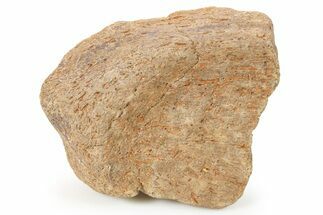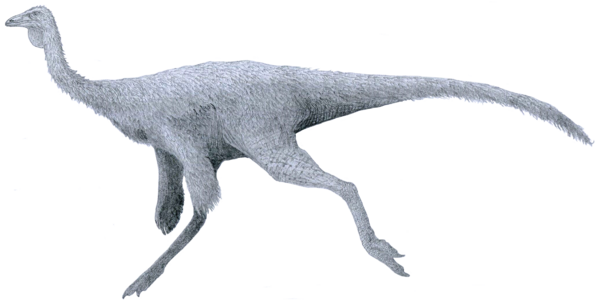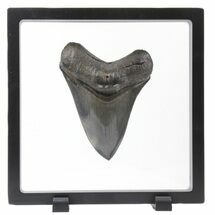This Specimen has been sold.
1.7" Fossil Dinosaur (Ornithomimus?) Phalanx Bone - Wyoming
This is a 1.7" long dinosaur phalanx (toe) bone, collected from our partner's lease on the Lance (Creek) Formation in Wyoming. It appears to be the toe bone of Ornithomimus sedens, an ornithomimid dinosaur known to roam North America between 76.5 and 66 million years ago.
Ornithomimus was a swift bipedal theropod that slightly resembled an ostrich: fossil evidence suggests that it was covered in feathers. It had a small toothless beak and clawed front appendages, indicating an omnivorous diet that likely included leaves, insects, fruits, and small mammals or lizards. It is estimated that they could reach upwards of 30 miles per hour (50 kilometers per hour).
About The Lance Formation
The Lance Formation of eastern Wyoming is a Late Cretaceous (69–66 million years old) unit that represents the same geologic age as the famous Hell Creek Formation of Montana and the Dakotas. Although they are time-equivalent, the Lance and Hell Creek preserve subtly different environments. Hell Creek reflects a humid, forested coastal plain punctuated by volcanic ash deposits, while the Lance records a slightly drier, more open floodplain landscape with broader river systems and fewer ash layers. Together, they provide a complementary view of life in the final chapter of the dinosaur era.
Perhaps the most famous Lance resident would be Tyrannosaurus rex, the largest North American carnivore to ever live. However, other smaller theropods also roamed the American midwest in this subtropical coastal stream system, including the beaked Ornithomimus, a lanky running theropod with a build similar to a modern ostrich, as well as several small predatory troodonts such as Paronychodon and Pectinodon.
Herbivorous dinosaurs also took advantage of the abundance offered by this unique era. Armored ankylosaurs dwelt in herds, their safety assured by their numbers, their heavy bone plating protecting most of their bodies and even their eyelids, and huge bone clubs on the ends of their tails providing them with powerful offensive capabilities. Ceratopsians like the famous Triceratops also formed protective herds, guarding their necks with frills and horns. Their smaller relatives, the dome-headed pachycephalosaurs, were also well represented in the area. Hadrosaurs, duck-billed titans with huge batteries of plant-grinding teeth in elongated snouts, are also well known from the region.
In addition to dinosaurs, a wide variety of fishes, amphibians, lizards, snakes, turtles, champsosaurs, crocodilians, and pterosaurs have been found in the formation.
The Lance Formation of eastern Wyoming is a Late Cretaceous (69–66 million years old) unit that represents the same geologic age as the famous Hell Creek Formation of Montana and the Dakotas. Although they are time-equivalent, the Lance and Hell Creek preserve subtly different environments. Hell Creek reflects a humid, forested coastal plain punctuated by volcanic ash deposits, while the Lance records a slightly drier, more open floodplain landscape with broader river systems and fewer ash layers. Together, they provide a complementary view of life in the final chapter of the dinosaur era.
Perhaps the most famous Lance resident would be Tyrannosaurus rex, the largest North American carnivore to ever live. However, other smaller theropods also roamed the American midwest in this subtropical coastal stream system, including the beaked Ornithomimus, a lanky running theropod with a build similar to a modern ostrich, as well as several small predatory troodonts such as Paronychodon and Pectinodon.
Herbivorous dinosaurs also took advantage of the abundance offered by this unique era. Armored ankylosaurs dwelt in herds, their safety assured by their numbers, their heavy bone plating protecting most of their bodies and even their eyelids, and huge bone clubs on the ends of their tails providing them with powerful offensive capabilities. Ceratopsians like the famous Triceratops also formed protective herds, guarding their necks with frills and horns. Their smaller relatives, the dome-headed pachycephalosaurs, were also well represented in the area. Hadrosaurs, duck-billed titans with huge batteries of plant-grinding teeth in elongated snouts, are also well known from the region.
In addition to dinosaurs, a wide variety of fishes, amphibians, lizards, snakes, turtles, champsosaurs, crocodilians, and pterosaurs have been found in the formation.
SPECIES
Ornithomimus sedens?
LOCATION
Wyoming
FORMATION
Lance Formation
SIZE
Bone: 1.7 x .85 x .85"
CATEGORY
SUB CATEGORY
ITEM
#306836
We guarantee the authenticity of all of our specimens.
 Reviews
Reviews













